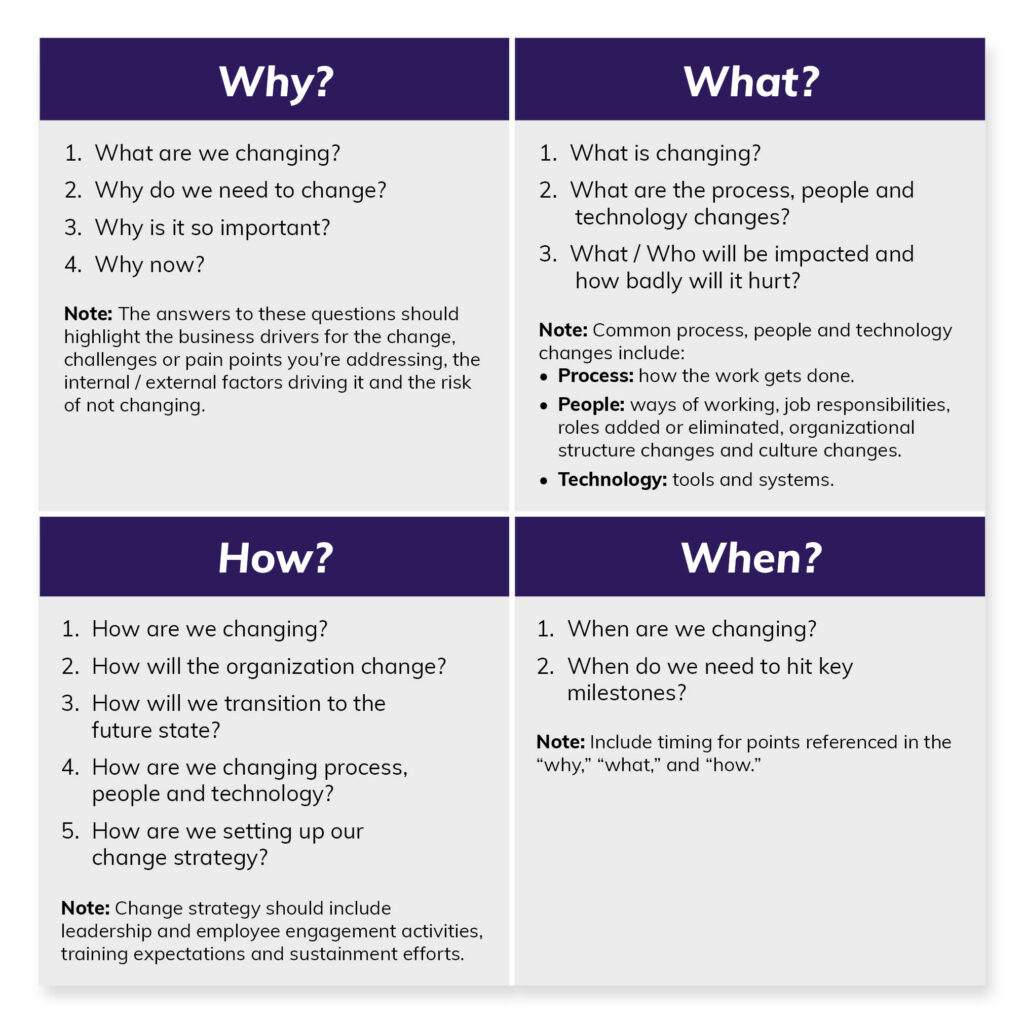To accept change, no matter how small or large, people need to know why it’s happening. Developing a collaborative change story that considers the views of all stakeholders is a powerful tool for enacting company-wide changes quickly and easily.
Change is hard for any organization. Change is even harder when project teams — including leaders — are unaware, or worse yet, disagree on what the change is and why it’s happening. If your company cannot clearly articulate the “what” and “why” of the change, you will unlikely have enough leadership or employee support to make it successful.
How are people supposed to change when they do not have a basic understanding of what is changing, and why are you asking them to do so?
Effective organizational change management (OCM) can increase the likelihood of a project or initiative successfully meeting objectives, finishing on time and within budget. As a change practitioner, one of the most powerful tools in your toolkit is establishing a collaborative change story.
In this blog, we’ll review the benefits and structure of the change story and best practices that will help you effectively collaborate and connect with your audience.
Incorporating Perspectives of Those Impacted into Your Collaborative Change Story
A change story is an easily understandable narrative that conveys the need for change, paints a picture of your desired future state, inspires action, and warns of the risks if people do not adopt the new processes.
Aside from being the foundational messaging platform for the OCM team, it is also a great tool for leaders and key stakeholders as it empowers them to speak with authority on the vision for change, how their teams and direct reports fit into that vision, and what’s in it for them if they adopt. Collaborating on your story helps ensure key stakeholders are aligned and support the vision for change. When stakeholders feel included in the plan and understand how they fit into the big picture, they feel agency in joining and taking ownership of their part in the journey.
Put simply, what makes a collaborative change story different is that you create it with consensus from both the change leaders’ voices and those impacted by it reflected in the solution, making the change more likely to stick. Ask yourself these questions to start thinking about ensuring everyone sees how they can benefit:
- What are the benefits of the change?
- How will this benefit our clients, the firm, and our employees?
- Why should they champion this project?
Note: these will be your talking points and should be short sound-bites employees can easily latch onto.
Stories Are How Humans Share, Connect and Easily Process Information
A change story is broken out into four sections, answering the primary questions:
- Why is the change happening?
- What are you changing?
- How does the organization plan to change?
- When will the change take place?
When possible, include the benefits the employees, company and their clients will receive if they support and adopt the change. When you lay out the benefits, stakeholders will understand the impact at multiple levels and recognize their role as beneficiaries of the change. Ideally, they will feel compelled to evangelize the change with their teams and become a change agent.
Always be mindful of your target audience. For example, it could be risky to include “cost savings” as a benefit to the company when that translates into layoffs for the employee. Tailor the story to your audience as change will look and feel differently across departments and teams in the organization.
For large initiatives, it is common to have a program-level change story to facilitate executive alignment and a project-level change story that speaks to each workstream to inspire change at an individual level.
Start with the “Why.” People need to connect with and see themselves reflected in the “why” to feel motivated to change. To summarize the book Start with Why: How Great Leaders Inspire Everyone to Take Action, by Simon Sinek, people do not buy into “what” you are changing — they buy into “why” you are doing it.
Use the below outline to organize your thoughts and facilitate a healthy discussion around your change story. Again, you should tailor this to your audience and what they will care about knowing.
A Collaboratively Developed Change Story Aligns Stakeholders
Before you get started, draft your assumptions, and identify potential gaps. To get up to speed quickly, request and review available project documentation such as the project charter, business case, statement of work (SOW), request for proposal (RFP), project plans, and interviews with key project leaders.
Once you’re familiar with the project, engage key stakeholders and request their participation in developing the change story.
Key stakeholders should include the project sponsor(s), business and functional leadership, and a select group of subject matter experts and impacted stakeholders. Active participation is critical to ensure your story is accurate and resonates with your audience. If stakeholders do not believe in why the change is necessary, they will not inspire others.
Best practices:
- Promote healthy, solution-focused discussions
- Listen for the concerns that come up and act on them
- Discuss gaps, mitigate risks and clarify any conflicting information found
- Have one person, either the project sponsor or delegate sign off on the final story.
You should base how you collaborate on the communication styles of your stakeholders and the time you have available. Working groups are very effective, but if you don’t have the luxury of time and open calendars, it might not be the best option for your project. Microsoft Teams and SharePoint are great virtual collaboration tools that allow for both flexibility and transparency.
A collaborative change story is an iterative process. It is not intended to be a quick exercise, and you will most likely have several rounds of review. When developed collaboratively, these stories have the power to help align stakeholders, manage resistance and uncover benefits.
Socialize, Listen and Don’t Be Afraid to Change
Lastly, socialize. Have stakeholders, especially the project sponsor, share the change story and motivate their teams, peers and direct reports. Make sure it’s accessible to employees and leadership. Reiterate and reinforce the change story messages in all employee communications.
Once the messages are out, it’s important to listen for feedback and make changes when appropriate. It’s okay to change your change story! It’s a living, breathing document, and you should make updates if and when the project changes.
Conclusion
We all know that change is hard. However, as change leaders, we have the power to make things a little easier. One of the most powerful tools in our toolkit is developing a change story in collaboration with those leading and impacted.
The collaborative change story shares the vision of the change and helps ensure leaders and employees know what is happening and what you expect of them. Incorporating their voices and perspectives in the solution and change approach will give your next change project or initiative the greatest chance of success.


